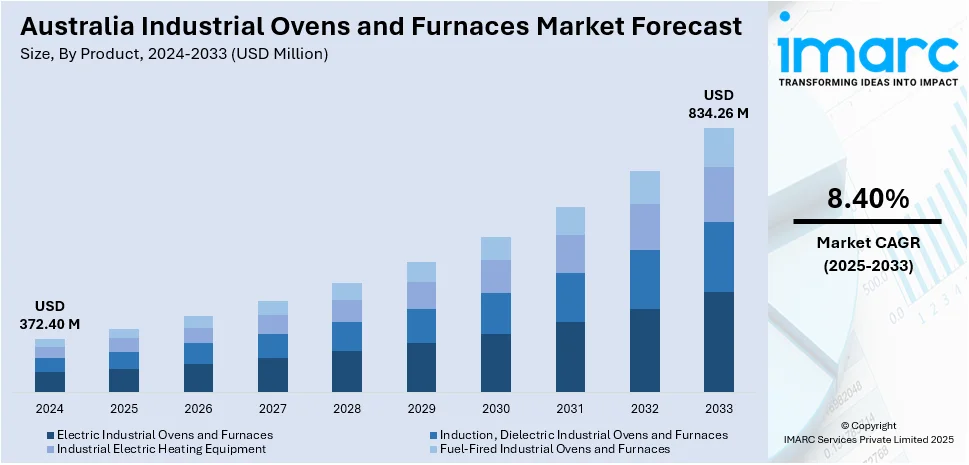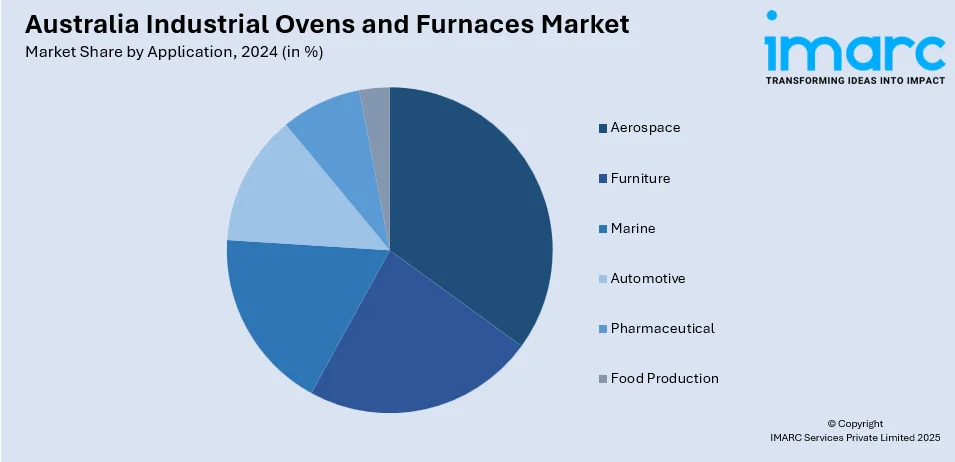
Australia Industrial Ovens and Furnaces Market Size, Share, Trends and Forecast by Product, Power Type, Application, and Region, 2025-2033
Australia Industrial Ovens and Furnaces Market Overview:
The Australia industrial ovens and furnaces market size reached USD 372.40 Million in 2024. Looking forward, IMARC Group expects the market to reach USD 834.26 Million by 2033, exhibiting a growth rate (CAGR) of 8.40% during 2025-2033. The market is evolving steadily, driven by advancements in manufacturing, increased demand for energy-efficient systems, and the integration of automation technologies. Key sectors such as metallurgy, automotive, and ceramics are adopting modern thermal processing solutions to enhance productivity and sustainability. This transition is shaping competitive dynamics and influencing the Australia industrial ovens and furnaces market share.
|
Report Attribute
|
Key Statistics
|
|---|---|
|
Base Year
|
2024
|
|
Forecast Years
|
2025-2033
|
|
Historical Years
|
2019-2024
|
| Market Size in 2024 | USD 372.40 Million |
| Market Forecast in 2033 | USD 834.26 Million |
| Market Growth Rate 2025-2033 | 8.40% |
Australia Industrial Ovens and Furnaces Market Trends:
Decarbonization and Sustainability Goals
Australia's pledge to reach net-zero emissions by 2050 has significantly impacted industrial operations, including those in the thermal processing sector. Companies are now substituting their old fossil-fueled ovens and furnaces with electric, hybrid and energy-efficient models to be more sustainable. Supportive policies, grants and carbon pricing motivate firms in steel, mining and food processing to use environmentally friendly technologies. Regulations and growing demands for corporate ESG responsibility help steer investments toward cleaner thermal technology. This transition is expected to intensify as climate policies become stricter and consumer demand for greener production increases, reinforcing sustainability as a core driver of innovation and modernization in Australia's industrial ovens and furnaces market.

To get more information on this market, Request Sample
Advanced Manufacturing and Technology Integration
The growth of advanced manufacturing sectors in Australia, such as aerospace, electronics, and precision engineering, requires highly specialized industrial ovens and furnaces. These industries demand equipment with exact temperature control, uniform heating, and energy efficiency to meet strict process standards. The integration of Industry 4.0 technologies, incorporating predictive maintenance, IoT sensors, and automation, has revolutionized the operational capabilities of thermal systems. Government programs supporting innovation, like the Modern Manufacturing Strategy, have encouraged investments in smart, connected furnace solutions. As more companies seek competitive advantages through productivity and efficiency, demand for technologically advanced ovens and furnaces continues to rise, making this factor a significant catalyst for the Australia industrial ovens and furnaces market growth.
Growth in the Mining and Metals Sector
Australia’s mining and metallurgical industries remain key pillars of its economy, with a strong need for industrial furnaces used in smelting, refining, and heat treatment. The country’s rich deposits of iron ore, lithium, and rare earth metals, coupled with rising global demand, fuel the continuous expansion and modernization of processing facilities. As mining companies aim to enhance output and reduce energy consumption, they are increasingly investing in advanced, energy-efficient furnace systems. Additionally, government support for downstream processing and local value addition, particularly in critical minerals, amplifies the requirement for high-performance thermal processing equipment. This demand from the mining and metals sector sustains long-term growth in the industrial ovens and furnaces market across Australia.
Australia Industrial Ovens and Furnaces Market Segmentation:
IMARC Group provides an analysis of the key trends in each segment of the market, along with forecasts at the country and regional levels for 2025-2033. Our report has categorized the market based on product, power type, and application.
Product Insights:
- Electric Industrial Ovens and Furnaces
- Induction, Dielectric Industrial Ovens and Furnaces
- Industrial Electric Heating Equipment
- Fuel-Fired Industrial Ovens and Furnaces
The report has provided a detailed breakup and analysis of the market based on the product. This includes electric industrial ovens and furnaces; induction, dielectric industrial ovens and furnaces; industrial electric heating equipment; and fuel-fired industrial ovens and furnaces.
Power Type Insights:
- Combustion Type
- Electric Type
The report has provided a detailed breakup and analysis of the market based on the power type. This includes combustion type and electric type.
Application Insights:

- Aerospace
- Furniture
- Marine
- Automotive
- Pharmaceutical
- Food Production
A detailed breakup and analysis of the market based on the application have also been provided in the report. This includes aerospace, furniture, marine, automotive, pharmaceutical, and food production.
Regional Insights:
- Australia Capital Territory & New South Wales
- Victoria & Tasmania
- Queensland
- Northern Territory & Southern Australia
- Western Australia
The report has also provided a comprehensive analysis of all the major regional markets, which include Australia Capital Territory & New South Wales, Victoria & Tasmania, Queensland, Northern Territory & Southern Australia, and Western Australia.
Competitive Landscape:
The market research report has also provided a comprehensive analysis of the competitive landscape. Competitive analysis such as market structure, key player positioning, top winning strategies, competitive dashboard, and company evaluation quadrant has been covered in the report. Also, detailed profiles of all major companies have been provided.
Australia Industrial Ovens and Furnaces Market News:
- In April 2024, Electrolux Group, a leading worldwide appliance business, commissioned a new electric-powered furnace at its Adelaide facility, marking a key step toward net-zero emissions in its operations. With about 450 South Australians working at its Dudley Park operation, Electrolux is the only home appliance manufacturer currently operating in Australia.
- In December 2024, the largest steelmaker and two of Australia's major iron ore miners decided to build the country’s biggest electric smelting furnace (ESF) pilot facility in the Kwinana Industrial Zone, which is south of Perth.
Australia Industrial Ovens and Furnaces Market Report Coverage:
| Report Features | Details |
|---|---|
| Base Year of the Analysis | 2024 |
| Historical Period | 2019-2024 |
| Forecast Period | 2025-2033 |
| Units | Million USD |
| Scope of the Report | Exploration of Historical Trends and Market Outlook, Industry Catalysts and Challenges, Segment-Wise Historical and Future Market Assessment:
|
| Products Covered | Electric Industrial Ovens and Furnaces, Induction, Dielectric Industrial Ovens and Furnaces, Industrial Electric Heating Equipment, Fuel-Fired Industrial Ovens and Furnaces |
| Power Types Covered | Combustion Type, Electric Type |
| Applications Covered | Aerospace, Furniture, Marine, Automotive, Pharmaceutical, Food Production |
| Regions Covered | Australia Capital Territory & New South Wales, Victoria & Tasmania, Queensland, Northern Territory & Southern Australia, Western Australia |
| Customization Scope | 10% Free Customization |
| Post-Sale Analyst Support | 10-12 Weeks |
| Delivery Format | PDF and Excel through Email (We can also provide the editable version of the report in PPT/Word format on special request) |
Key Questions Answered in This Report:
- How has the Australia industrial ovens and furnaces market performed so far and how will it perform in the coming years?
- What is the breakup of the Australia industrial ovens and furnaces market on the basis of product?
- What is the breakup of the Australia industrial ovens and furnaces market on the basis of power type?
- What is the breakup of the Australia industrial ovens and furnaces market on the basis of application?
- What is the breakup of the Australia industrial ovens and furnaces market on the basis of region?
- What are the various stages in the value chain of the Australia industrial ovens and furnaces market?
- What are the key driving factors and challenges in the Australia industrial ovens and furnaces market?
- What is the structure of the Australia industrial ovens and furnaces market and who are the key players?
- What is the degree of competition in the Australia industrial ovens and furnaces market?
Key Benefits for Stakeholders:
- IMARC’s industry report offers a comprehensive quantitative analysis of various market segments, historical and current market trends, market forecasts, and dynamics of the Australia industrial ovens and furnaces market from 2019-2033.
- The research report provides the latest information on the market drivers, challenges, and opportunities in the Australia industrial ovens and furnaces market.
- Porter's five forces analysis assist stakeholders in assessing the impact of new entrants, competitive rivalry, supplier power, buyer power, and the threat of substitution. It helps stakeholders to analyze the level of competition within the Australia industrial ovens and furnaces industry and its attractiveness.
- Competitive landscape allows stakeholders to understand their competitive environment and provides an insight into the current positions of key players in the market.
Need more help?
- Speak to our experienced analysts for insights on the current market scenarios.
- Include additional segments and countries to customize the report as per your requirement.
- Gain an unparalleled competitive advantage in your domain by understanding how to utilize the report and positively impacting your operations and revenue.
- For further assistance, please connect with our analysts.
 Request Customization
Request Customization
 Speak to an Analyst
Speak to an Analyst
 Request Brochure
Request Brochure
 Inquire Before Buying
Inquire Before Buying




.webp)




.webp)












